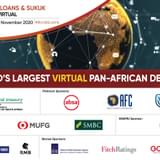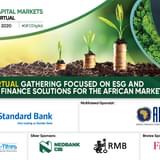Q. KPWF is planning a 1.5 billion shilling ($15 million) bond this year to fund Kenyan water utilities. What are some of the things driving you to issue a green bond over a conventional instrument?
A. This is a crucial moment for the water sector in Kenya. What we are now witnessing is the first foray of the public water and sanitation infrastructure into private sector funding. Previously, these sectors have been developed either through government grants, donor grants, or development finance banks lending through the national sovereign which then on-lend to the sector.
The funding challenges being faced by the sector currently are significant. The funding gap in the water and sanitation sector currently stands at KES1.1tn, which will be required to meet the government’s Vision 2030 objectives related specifically to providing water and sanitation services for all. Those estimates have already taken into account available resources from the public sector. To fill that gap, new funding solutions for the water sector must be identified, and the capital markets is seen as one of the means by which financial viable entities can access the long-term funding they require.
This is critical because Kenya has progressed to become a middle-income country, and therefore – in donor circles – is no longer eligible to secure grants and other lower-cost funding lines previously open to it. So there are very few options other than to access commercial funding in order to expand services.
At the same time, we are on the tail end of about two decades of regulatory reform – and some of that reform has resulted in a conducive environment for which private institutional lenders can assess new investment opportunities in this sector.
On the green element specifically: water is a natural resource, and is green by its very nature, and these companies need to employ sustainable strategies for managing their resources, and to ensure those strategies are climate resilient in order to ensure the long-term viability of their operations. It is our hope that by deciding to issue green bonds, other companies will start to think a bit deeper when designing and identifying projects and activities to expand operations, and think about sustainability in the long term. We also hope that by putting forward green projects, and companies that are thinking green, their governance standards will also be raised – not just with respect to their environmental impact. This should reflect well on these entities in the eyes of investors. Finally, it’s simply the case that in the long term, everyone has to think about sustainability, so there’s no better time like the present to get in front of this.
Q. The issuance, as we understand it, is three years in the making. What were some of the key elements that needed to be in place before you hit the market?
A. There are a number of challenges split into two broad streams: the challenge related to the capital markets, and the challenges related to borrowers specifically. We are lucky in Kenya in that the capital markets is well-developed, well-structured, and well-regulated. However, the water sector is undergoing significant change. Water sector regulators in the country have been in place since 1992, and they ringfenced water utilities to be separate from their local governments. In 2002, a new period of regulatory reform began, which culminated in the constitutional overhaul of 2010 and placed the function of water services to local governments as part of a wider devolution of powers.
Early on, when the Kenya Pooled Water Fund started, the key issue was to review the regulatory environment and legal regime in place to determine if water companies can borrow from private lenders; whether the government itself was open to the idea of allowing water companies to petition private investors for funding; to see whether the regulatory environment surrounding the capital markets specifically would allow for pooled bonds – essentially asset backed securities; and to analyse default scenarios and what their implications would be.
Then we had to estimate the potential market size of the water sector. We think the market is roughly KES5bn per year, possibly higher in five years onward. We also evaluated different paths of market entry for water utilities.
All of this took about 18 months to complete. We were very fortunate that the Dutch government, through its development aid budget, agreed to take this on as one of its initiatives; it was quite an undertaking from a cost point of view, but the Dutch government was crucial in helping us ensure all of the key elements are in place to facilitate this issue.
Q. What kinds of reporting has the KPWF committed to in relation to the green bond?
A. Today, water companies – being regulated entities – have continuous reporting obligations under their established provision licenses, and that reporting, which is then correlated by the water sector regulator and disseminated publicly through its website, include governance and financial metrics. The capital markets also has continuous reporting requirements on bonds and any similar liquid instruments, to which we must comply. Use of proceeds is of course set out in the information memorandum at the time of issuance, and we will report performance on use of proceeds regularly.
The impact of the underlying projects will be described and explained in the information memorandum, and we will disseminate any information if there are any outcomes that stray from that. We also have certain reporting requirements related to ESG as part of the donor community’s participation with the KPFW, and we will collate and disseminate these as well.
We don’t have specific green reporting requirements related to the capital markets. This initiative is being led by the Central Bank and the Ministry of Finance. At the moment, the government is simply looking to encourage more supply, but the reporting framework on the green aspect has yet to be designed. I suspect that will come through in due course.
Q. What is the government doing to try and encourage issuers – beyond simply visibility-raising?
A. Kenya’s capital markets in general is suffering from a lack of supply, but not a lack of investors. At the moment, investors will buy anything that gives them a decent return for reasonable risk. Our issue here is that we have potential issuers that are concerned about the borrowing costs of a green bond, and the ongoing reporting costs. The government’s position is that there is an inherent advantage to issuing green – that it improves the liquidity of an entity’s issuance going forward, by appealing a to wider range of specialist funds. The government could introduce some kinds of tax incentives, but I think it’s more likely the government would target all types of capital market credit instruments because it is fairly keen to grow generic and green supply at the same time.
Q. What is your perception of the extent to which local investors value ESG-linked capital markets instruments?
A. I think it’s still early days. I don’t think many local investors are that nuanced at this point. However, it’s important to point out that there are differences between long-term institutional investors, or fund trustees, and asset managers. The largest pool of capital markets investors in Kenya are pension funds, and we tend to find they are more sensitive – or more willing to – invest in initiatives that have a direct link to improving people’s wellbeing. That’s the profile of the services we offer – we have a direct impact on the ability to minimise disease through better sanitation and greater access to water. So, whenever we sit down with trustees and pension funds, they get it; but the challenge is getting them to understand the risks inherent to the sector and how they are managed, given the fact that the sector in Kenya has never really been accessible from a private investment perspective.
Q. Do you see the market for ESG-linked instruments growing in Kenya? And if so, what do you think will be the main drivers for local issuers?
A. The biggest driver of debt issuance over the past 20 years has been government, whether directly or through state-owned enterprises. The country is rich in natural resources – particularly of the non-mining variety – and these include water, renewable energy, and wildlife-related sectors among others.
When you look at those sectors, it’s easy to see potential for greater issuance. The government, which will probably be the main catalyst in the short term, is in the process of looking at issuing green bonds; it’s early days, but they are warming to the idea. KenGen has been looking at issuing green bonds to finance geothermal power projects among others. These kinds of projects have a huge impact on the environment and are appealing to investors. The other thing to keep in mind is that even if borrowers like these were to go to the banking market to fund these projects, they would still need to go through much of the same due diligence and environmental impact assessment that they would otherwise do to issue a green bond. That being said, as the impetus for diversification grows, so too will the willingness to go to the green bond market to finance these kinds of projects. This will boost local liquidity in the medium term, and help incentivise other borrowers to tap the market.









